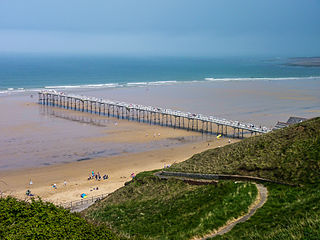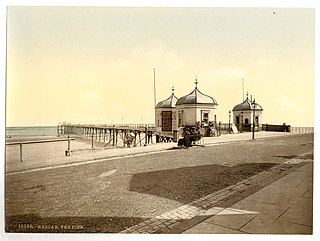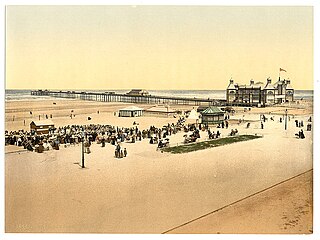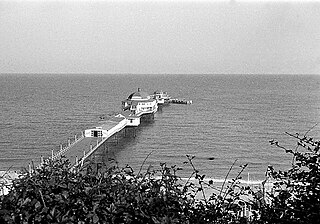
Ryde Pier is an early 19th century pier serving the town of Ryde, on the Isle of Wight, off the south coast of England. It is the world's oldest seaside pleasure pier. Ryde Pier Head railway station is at the sea end of the pier, and Ryde Esplanade railway station at the land end, both served by Island Line trains.

Southport Pier is a pleasure pier in Southport, Merseyside, England. Opened in August 1860, it is the oldest iron pier in the country. Its length of 1,108 m (3,635 ft) makes it the second-longest in Great Britain, after Southend Pier. Although at one time spanning 1,340 m (4,380 ft), a succession of storms and fires during the late 19th and early 20th centuries reduced its length to that of the present day.

North Pier is the most northerly of the three coastal piers in Blackpool, England. Built in the 1860s, it is also the oldest and longest of the three. Although originally intended only as a promenade, competition forced the pier to widen its attractions to include theatres and bars. Unlike Blackpool's other piers, which attracted the working classes with open air dancing and amusements, North Pier catered for the "better-class" market, with orchestra concerts and respectable comedians. Until 2011, it was the only Blackpool pier that consistently charged admission.

Llandudno Pier is a Grade II* listed pier in the seaside resort of Llandudno, North Wales, United Kingdom. At 2,295 feet (700 m), the pier is the longest in Wales and the fifth longest in England and Wales. In 2005, was voted "Pier of the Year 2005" by the members of the National Piers Society.

Herne Bay Pier was the third pier to be built at Herne Bay, Kent for passenger steamers. It was notable for its length of 3,787 feet (1,154 m) and for appearing in the opening sequence of Ken Russell's first feature film French Dressing. It was destroyed in a storm in 1978 and dismantled in 1980, leaving a stub with sports centre at the landward end, and part of the landing stage isolated at sea. It was preceded by two piers: a wooden deep-sea pier designed by Thomas Rhodes, assistant of Thomas Telford, and a second shorter iron version by Wilkinson & Smith.

Saltburn Pier is a pier located in Saltburn-by-the-Sea, Redcar and Cleveland and the ceremonial county of North Yorkshire, England. It is the last pier remaining in Yorkshire.

St Annes Pier is a Victorian era pleasure pier in the English seaside resort of St Annes-on-the-Sea, Lancashire. It lies on the estuary of the River Ribble. The pier, designed by Alfred Dowson, was completed in 1885 and was one of the earliest public buildings in St Annes, a 19th-century planned town. The pier was originally intended to be a sedate promenading venue for the resort's visitors, but attractions were later added. Changes made to the estuary channels to improve access to Preston Dock left the pier on dry land and ended its steamer services to Blackpool and Liverpool.

Penarth Pier is a Victorian era pier in the town of Penarth, Vale of Glamorgan, South Wales. The pier was opened in 1898 and was a popular attraction to seaside-goers at the time, who also enjoyed trips on pleasure steamers that operated from the pier. It has on several occasions been damaged by vessels colliding with the structure and in 1931, a fire broke out in one of the pavilions. This wooden pavilion was never replaced, but a concrete pavilion has been used over the years as a concert hall, ballroom, cinema and for other purposes. It is currently home to the Penarth Pier Pavilion.

Portobello Pier was a pleasure pier opened in Portobello, Edinburgh, Scotland. Designed by Thomas Bouch, it was 1,250 feet (380 m) long and 22 feet wide, and included a tea room, camera obscura, and a concert hall. The final construction costs were £10,000.

Withernsea Pier was a pier in the town of Withernsea, East Riding of Yorkshire, England. The pier was constructed between 1875 and 1877 to attract daytrippers, but was beset by accidents from the outset. Storms and ship-caused damage led to the pier being closed by 1893, and it was completely dismantled by 1903, leaving only the distinctive castellated pier towers on the seafront, which are still there to this day.

Lytham Pier, a pleasure and working pier, was opened in the seaside town of Lytham, Lancashire, England in 1865, in the face of reservations from local residents. The pier underwent several renovations during the 1890s and early 1900s before being badly damaged by a storm in 1903, during which two barges collided with the structure and split it in two. A fire in 1928 resulted in extensive damage to the pavilion, which was not rebuilt, although the pier itself was reopened several months later. Following a period of decline it was closed to the public shortly before the outbreak of the Second World War. The pier was demolished in 1960 despite the protests of thousands of local residents.

Redcar Pier was a Victorian pleasure and landing pier constructed on The Esplanade in the seaside town of Redcar on the north east coast of Yorkshire, England.

Coatham Pier or Victoria Pier, Coatham, was a pleasure pier built on Newcomen Terrace in the Coatham area of Redcar on the north-east Yorkshire coast.

Central Pier was one of two piers in Morecambe, Lancashire, England. Built during the late 1860s, it was 912 feet (278 m) long and featured a large pier head served by steamboats. Two significant fires occurred during its lifetime, one in 1933 destroying the pavilion then dubbed the "Taj Mahal of the North", and another in 1991, the latter which condemned the pier as unsafe and demolition took place the following year in 1992.

West End Pier was one of two piers in Morecambe, Lancashire, England, built during the late 19th century to an eventual length of 1,800 feet (550 m) long and officially opened on 3 April 1896 by Colonel William Henry Foster MP. The pier was one of the first structures in the town to be installed with electric lighting in 1899.

Rhyl Pier, officially known as the Victoria Pier, was a pleasure pier in the seaside town of Rhyl, Flintshire, and the first to be built in North Wales. Designed by James Brunlees and opened in August 1867 at a length of 2,355 feet (718 m), it was the town's central attraction for the ensuing years. Following dispute and public consultation regarding the location it would be built, the pier was constructed near the centre of the esplanade. The pier's Grand Pavilion, built in 1891, featured the world's largest organ, known as the Grand Jubilee Organ and weighed 25 tonnes.

Shanklin Pier was a pleasure pier in the town of Shanklin on the Isle of Wight, England. Opened in August 1890 at a length of 1,200 feet (370 m), the pier saw several attractions added during its first few years, such as a bandstand and bathing stage. A pavilion was added in 1901.

New Brighton Pier was a pleasure and fishing pier in New Brighton, Wallasey in England, built during the late 1860s at a length of 600 feet (180 m).

Lytham St Annes Town Hall is a municipal building on the South Promenade in Lytham St Annes, Lancashire, England. The structure, which is used as the headquarters of Fylde Borough Council, is a locally listed building.
Whitley Bay Pier was an unrealised pleasure pier to be built at Whitley Bay, North Tyneside, on the north-east coast of England. Substantial proposals for such a pier were first made in 1908; next in 1935-39 and lastly in 1966–72. Although Orders and Local Acts of Parliament permitting the development were repeatedly passed, construction of the various schemes never started.



















